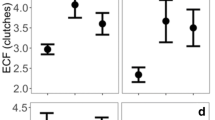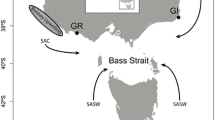Abstract
We investigated the possible effects of a 12-g data-logger attached to a darvic ring on the performance of Cory’s shearwater (Calonectris diomedea, 600–850 g) from two different colonies in the western Mediterranean Sea. We compared return rates, current breeding success and body condition between equipped and unequipped birds. Effects on feeding ecology during winter and breeding period was also evaluated through the measurement of stable isotopes of carbon (δ13C) and nitrogen (δ15N) in one of the colonies. We found no evidence of negative effects of loggers on demographic parameters analysed or in feeding ecology. Power analyses suggested a high power to detect medium effect size, but a low power to detect small changes. Despite the non-significant results we could only exclude medium to strong effects of the devices on one of these parameters. We detected some short-term negative effects on body condition for the equipped birds, but these were unlikely to have had important consequences. Results suggest that the use of loggers is an adequate methodology to obtain information from seabirds at sea, but data should be carefully interpreted with regard to potential biases during severe environmental conditions.


Similar content being viewed by others
References
Afanasyev V (2004) A miniature daylight level and activity data recorder for tracking animals over long periods. Mem Natl Inst Polar Res 58[Spec Issue ]:227–233
Bakken GS, Reynolds PS, Kenow KP, Korschgen CE, Boysen AF (1996) Thermoregulatory effects of radiotelemetry transmitters on mallard ducklings. J Wildl Manag 60:669–678
Ballard G, Ainley DG, Ribic CA, Barton KR (2001) Effect of instrument attachment and other factors on foraging trip duration and nesting success of Adelié penguins. Condor 103:481–490
Bannasch R, Wilson RP, Culik B (1994) Hydrodynamic aspects of design and attachment of a back-mounted device in penguins. J Exp Biol 194:83–96
Bro E, Clobert J, Reitz F (1999) Effects of radiotransmitters on survival and reproductive success of gray patridge. J Wildl Manag 63:1044–1051
Caccamise DF, Hedin RS (1985) An aerodynamic basis for selecting transmitter loads in birds. Wilson Bull 97:306–318
Calvo B, Furness RW (1992) A review of the use and the effects of marks and devices on birds. Ringing Migr 13:129–151
DeNiro MJ, Epstein S (1978) Influence of diet on the distribution of carbon isotopes in animals. Geochim Cosmochim Acta 45:495–506
DeNiro MJ, Epstein S (1981) Influence of diet on the distribution of nitrogen isotopes in animals. Geochim Cosmochim Acta 45:341–351
Ekstrom PA (2004) An advance in geolocation by light. Mem Natl Inst Polar Res (Jpn) 58[Spec Issue]:210–226
Erdfelder E, Faul F, Buchner A (1996) G*Power: a general power analysis program. Behav Res Methods Instrum Comput 28:1–11
Forero MG, Hobson KA (2003) Using stable isotopes of nitrogen and carbon to study seabird ecology: applications in the Mediterranean seabird community. Sci Mar 67:23–32
Garthe S, Grémillet D, Furness RW (1999) At-sea-activity and foraging efficiency in chick-rearing northern gannets Sula bassana: a case study in Shetland. Mar Ecol Prog Ser 185:93–99
Genovart M (2001) Seguiment de la colònia de cria de virot (Calonectris diomedea) a l’illot d’Es Pantaleu. An Ornithol Bal 16:23–27
Gessaman JA, Fuller MR, Pekinsand PJ, Duke GE (1991) Resting metabolic rate of golden eagles, bald eagles, and barred owls with a tracking transmitter or a equivalent load. Wilson Bull 103:261–265
González-Solís J, Croxall JP, Wood A (2000) Foraging partitioning between giant petrels Macronectes spp. and its relationship with breeding population changes at Bird Island, South Georgia. Mar Ecol Prog Ser 204:279–288
Hamer KC, Phillips RA, Hill JK, Wanless S, Wood AG (2001) Contrasting foraging strategies of gannets Morus bassanus at two North Atlantic colonies: foraging trip duration and foraging area fidelity. Mar Ecol Prog Ser 224:283–290
Hawkins P (2004) Bio-logging and animal welfare: practical refinements. Mem Natl Inst Polar Res (Jpn) 58[Spec Issue]:58–68
Hedd A, Gales R, Brothers N (2001) Foraging strategies of shy albatross Thalassarche cauta breeding at Albatross Island, Tasmania, Australia. Mar Ecol Prog Ser 224:267–282
Hedin RS, Caccamise DF (1982) A method for selecting transmitter weights based on energetic cost of flight. Trans Northeast Fish Wildl Conf 39:115
Hill RD (1994) Theory of geolocation by light levels. In: Le Boeuf BJ, Laws RM (eds) Elephant seals: population ecology, behavior, and physiology. University of California Press, Berkeley, pp 227–236
Hobson KA (1993) Trophic relationships among high Arctic seabirds: insights from tissue-dependent stable-isotope models. Mar Ecol Prog Ser 95:7–18
Hobson KA, Clark RG (1992) Assessing avian diets using stable isotopes. I. Turnover of carbon-13. Condor 94:181–188
Hobson KA, Piatt JF, Pitocchelli J (1994) Using stable isotopes to determine seabird trophic relationships. J Anim Ecol 63:786–798
Hull CL (1997) The effect of carrying devices on breeding royal penguins. Condor 99:530–534
Igual JM, Gómez T (2000) Seguimiento de la productividad de la pardela cenicienta (Calonectris diomedea) en las islas Chafarinas. In: Control y seguimiento de los ecosistemas en el Refugio Nacional de caza de las islas Chafarinas, vol II. Organismo Autónomo de Parques Nacionales, pp 124–151
Jennions DM, Møller AP (2003) A survey of the statistical power of research in behavioural ecology and animal behavior. Behav Ecol 14:438–445
Michener RH, Schell DM (1994) Stable isotope ratios as tracers in marine and aquatic food webs. In: Lajtha K, Michener RH (eds) Stable isotopes in ecology and environmental science. Blackwell Scientific Publications, Oxford, pp 139–157
Monteiro LR, Furness RW (1996) Moult of Cory’s shearwater during the breeding season. Condor 98:216–221
Murray DL, Fuller MR (2000) A critical review of the effects of marking on the biology of vertebrates. In: Boitani L, Fuller TK (eds) Research techniques in animal ecology. Controversies and consequences. Columbia University Press, New York, pp 15–64
Phillips RA, Xavier JC, Croxall JP (2003) Effects of satellite transmitters on albatrosses and petrels. Auk 120:1082–1090
Phillips RA, Silk JRD, Croxall JP, Briggs DR, Afanasyev V (2004) Accuracy of geolocation estimates for flying seabirds. Mar Ecol Prog Ser 266:265–272
Sedinger JR, White RG, Harer WE (1990) Effects of carrying radio transmitters on energy expenditure of Pacific black blant. J Wildl Manag 54:42–45
Söhle IS (2004) Effects of satellite telemetry on sooty shearwater, Puffinus griseus, adults and chicks. Emu 103:373–379
Taylor SS, Leonard ML, Boness DJ, Majluf P (2001) Foraging trip duration increases for Humbolt penguins tagged with recording devices. J Avian Biol 32:369–372
Tuck GN, Polacheck T, Croxall JP, Weimerskirch H, Prince PA, Wotherspoon S (1999) The potential of archival tags to provide long-term movements and behaviour data for seabirds: first results from wandering albatross Diomedea exulans of South Georgia and Crozet Islands. Emu 99: 60–68
Wanless S, Morris JA, Harris MP (1988a) Diving behaviour of guillemots Uria aalge, puffin Fratercula arctica, and razorbill Alca torda as shown by radio-telemetry. J Zool 216:73–81
Wanless S, Harris MP, Morris JA (1988b) The effect of radio transmitters on the behaviour of common murres and razorbills during chick rearing. Condor 90:816–823
Warham J (1990) The petrels. Their ecology and breeding systems. Academic, London
Wilson RP, Culik BM (1992) Packages of penguins and device-induced data. In: Priede GI, Swift SM (eds) Wildlife telemetry: remote monitoring and tracking of animals. . Ellis Horwood, New York, pp 573–580
Wilson RP, Weimerskirch H, Lys P (1995) A device for measuring seabird activity at sea. Avian Biol 26:172–175
Wilson RP, Pütz K, Peters G, Culik BM, Scolaro JA, Charrassin JB, Ropert-Coudert Y (1997) Long term attachment of transmitting and recording devices to penguins and other seabirds. Wildl Soc Bull 25:101–106
Wilson RP, Gremillet D, Syder J, Kierspel AM, Garthe S, Weimerskirch H, Schäfer-Neth C, Scolaro JA, Bost Ch-A, Plötz J, Nel D (2002) Remote-sensing systems and seabirds: their use, abuse and potential for measuring marine environmental variables. Mar Ecol Prog Ser 228:241–261
Acknowledgements
We are very grateful to GENA (especially to T. Gomez and I. Afán) and to J. Zapata (Director of Chafarinas Islands Hunting National Refugee) for their help. At Pantaleu, M. Mayol and the wardens of Dragonera gently provided logistic support. We also thank the people who helped during the field work, especially M. Genovart and the wardens of the Columbretes (R. Berenguer and V. Ferrís). We also thank J.P. Croxall, V. Afanasyev and D. Briggs for making available geolocators for this study. P. Healy assisted with preparation of samples for stable isotope analysis, which were analysed at the Department of Soil Science, University of Saskatchewan, Canada. M.G.F. and J.G.S. were supported by a contract of the Program Ramon y Cajal of the Spanish Ministerio de Ciencia y Tecnología (MCyT). Additional support was provided by the grants REN2002–00450/GLO and BOS2003–01960 from MCyT. We are also grateful to three anonymous referees for improving a previous draft of the manuscript, and to R. Pradel for his help and comments on power analyses.
Author information
Authors and Affiliations
Corresponding author
Additional information
Communicated by S.A. Poulet, Roscoff
Rights and permissions
About this article
Cite this article
Igual, J.M., Forero, M.G., Tavecchia, G. et al. Short-term effects of data-loggers on Cory’s shearwater (Calonectris diomedea). Marine Biology 146, 619–624 (2005). https://doi.org/10.1007/s00227-004-1461-0
Received:
Accepted:
Published:
Issue Date:
DOI: https://doi.org/10.1007/s00227-004-1461-0




